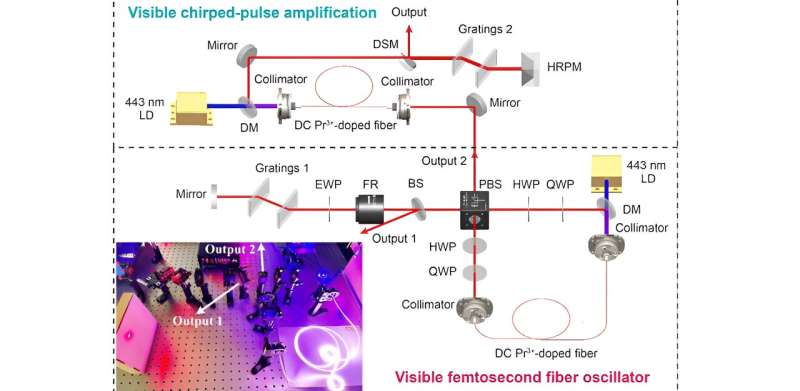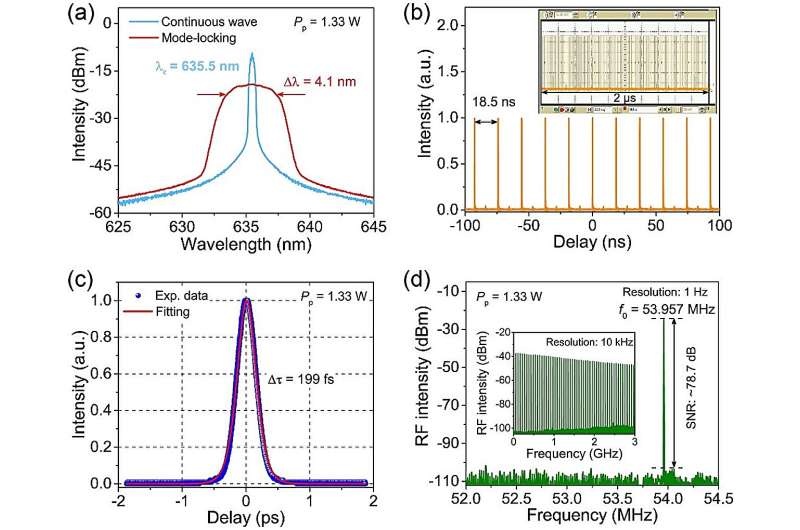This article has been reviewed according to Science X's editorial process and policies. Editors have highlighted the following attributes while ensuring the content's credibility:
fact-checked
trusted source
proofread
Unlocking visible femtosecond fiber oscillators: An advance in laser science

The emergence of ultrafast laser pulse generation, marking a significant milestone in laser science, has triggered incredible progress across a wide array of disciplines, encompassing industrial applications, energy technologies, life sciences, and beyond. Among the various laser platforms that have been developed, fiber femtosecond oscillators, esteemed for their compact design, outstanding performance and cost-effectiveness have become one of the mainstream technologies for femtosecond pulse generation.
However, their operating wavelengths are predominantly limited to the infrared region, spanning from of 0.9-3.5 μm, which has, in turn, restricted their applicability in numerous applications that require light sources at visible wavelengths (390-780 nm). Expanding compact femtosecond fiber oscillators into new visible wavelengths has long been a challenging yet fervently pursued goal in laser science.
Currently, the majority of visible fiber lasers use rare-earth-doped fluoride fibers, such as Pr3+, as the effective gain medium. Over the years, remarkable advancements have been made in developing wavelength-tunable, high-power, Q-switched and mode-locked visible fiber lasers.
However, despite the significant progress in the near-infrared region, achieving femtosecond mode-locking in visible fiber lasers remains an exceptionally challenging task. This challenge is attributed to the underdevelopment of ultrafast optics components at visible wavelengths, limited availability of high-performance visible modulators, and the extremely normal dispersion encountered in visible fiber laser cavities.
Recent attention has focused on femtosecond mode-locked fiber oscillators in near-infrared using a phase-biased nonlinear amplifying loop mirror (PB-NALM). PB-NALM eliminates the need for long intracavity fibers to accumulate phase shifts.
This innovation not only facilitates tuning flexibility and long-life operation but also provides an opportunity to manage the intracavity dispersion in a larger parameter space from normal to anomalous dispersion regimes. Consequently, it is anticipated to catalyze a breakthrough in direct femtosecond mode-locking of visible fiber laser and propel fiber femtosecond oscillators into the visible band.

Researchers from the Fujian Key Laboratory of Ultrafast Laser Technology and Applications at Xiamen University recently developed a visible-light mode-locked femtosecond fiber oscillator and amplifier, as reported in Advanced Photonics Nexus.
The fiber femtosecond oscillator, which emits red light at 635 nm, employs a figure-nine cavity configuration. It applies a double-clad Pr3+-doped fluoride fiber as the visible gain medium, incorporates a visible-wavelength PB-NALM for mode-locking, and utilizes a pair of customized high-efficiency and high-groove-density diffraction gratings for dispersion management. A visible self-starting mode-locking established by the PB-NALM directly yields red laser pulses with a pulse duration of 199 fs and a repetition rate of 53.957 MHz from the oscillator.
Precise control of the grating pair spacing can switch the pulse state from a dissipative or stretched-pulse soliton to a conventional soliton. Additionally, a chirped-pulse amplification system built alongside the oscillator boosts the laser performance immensely, resulting in an average output power over 1 W, a pulse energy of 19.55 nJ, and a dechirped pulse duration of 230 fs.
Prof. Zhengqian Luo, head of the Electronic Engineering Department of Xiamen University, says, "Our result represents a concrete step toward high-power femtosecond fiber lasers covering the visible spectral region and could have important applications in industrial processing, biomedicine, and scientific research."
The authors anticipate that their new scheme for high-performance visible-light femtosecond fiber laser generation will lay the foundations for visible-light femtosecond fiber lasers to serve in applications such as special material precision processing, biomedicine, underwater detection, and optical atomic clocks.
More information: Jinhai Zou et al, 635 nm femtosecond fiber laser oscillator and amplifier, Advanced Photonics Nexus (2024). DOI: 10.1117/1.APN.3.2.026004
Provided by SPIE





















